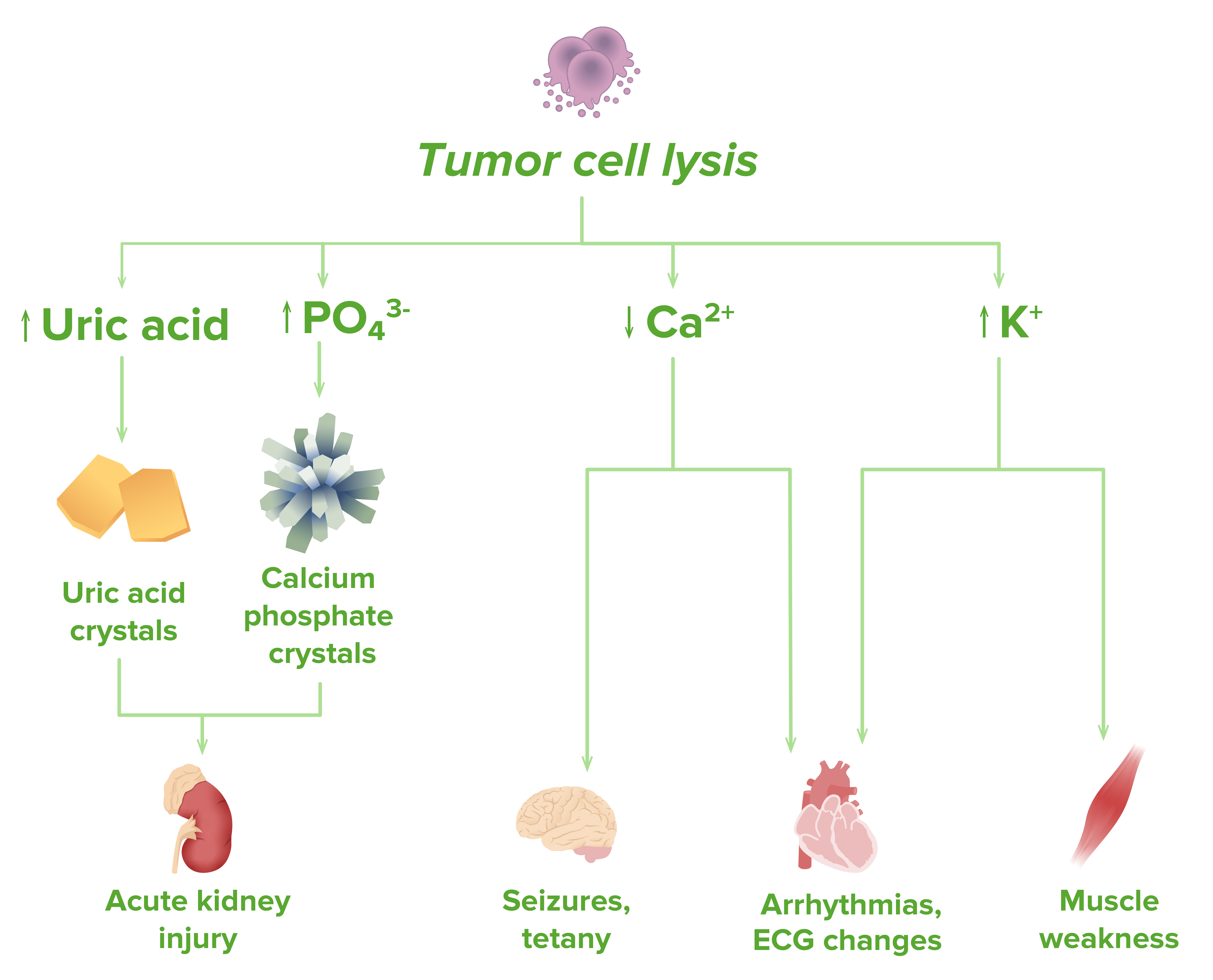Tumor lysis syndrome is a potentially lethal group of metabolic disturbances that occurs when large numbers of cancer cells are killed rapidly. The lysed cells release their intracellular contents into the bloodstream, resulting in the development of hyperkalemia, hyperuricemia, hyperphosphatemia, hypocalcemia, and acute kidney injury. This can lead to severe neurologic, cardiac, gastrointestinal, and urinary signs and symptoms. The diagnosis is made based on the metabolic derangements seen on laboratory evaluation in conjunction with the clinical history. In addressing tumor lysis syndrome, the goal is to initiate therapy early for those at high risk, including IV hydration, close electrolyte monitoring and correction, and hypouricemic agents.
Last updated: Mar 4, 2024
National incidence Incidence The number of new cases of a given disease during a given period in a specified population. It also is used for the rate at which new events occur in a defined population. It is differentiated from prevalence, which refers to all cases in the population at a given time. Measures of Disease Frequency reports are hampered by a lack of standard criteria for diagnosis.
Tumor lysis Tumor Lysis Tumor Lysis Syndrome syndrome results from massive tumor Tumor Inflammation death and is primarily associated with the following hematologic malignancies:
Malignancy Malignancy Hemothorax characteristics:
Concurrent conditions:
Tumor lysis Tumor Lysis Tumor Lysis Syndrome syndrome occurs secondary to the chemotherapeutic treatment of malignancies, resulting in massive cell destruction.

Pathophysiology of tumor lysis syndrome
Image by Lecturio.
Histologic images taken from a patient with leukemia:
Left: The white areas represent extreme apoptosis of leukemic cells. Cell destruction leads to a release of potassium, phosphate, and nucleic acids, which contributes to tumor lysis syndrome.
Right: higher magnification of viable and proliferating leukemic cells
Symptoms typically occur within 72 hours of the initiation of cytotoxic Cytotoxic Parvovirus B19 therapy and are the consequence of hyperkalemia Hyperkalemia Hyperkalemia is defined as a serum potassium (K+) concentration >5.2 mEq/L. Homeostatic mechanisms maintain the serum K+ concentration between 3.5 and 5.2 mEq/L, despite marked variation in dietary intake. Hyperkalemia can be due to a variety of causes, which include transcellular shifts, tissue breakdown, inadequate renal excretion, and drugs. Hyperkalemia, hyperphosphatemia Hyperphosphatemia A condition of abnormally high level of phosphates in the blood, usually significantly above the normal range of 0. 84-1. 58 mmol per liter of serum. Hypocalcemia, hypocalcemia Hypocalcemia Hypocalcemia, a serum calcium < 8.5 mg/dL, can result from various conditions. The causes may include hypoparathyroidism, drugs, disorders leading to vitamin D deficiency, and more. Calcium levels are regulated and affected by different elements such as dietary intake, parathyroid hormone (PTH), vitamin D, pH, and albumin. Presentation can range from an asymptomatic (mild deficiency) to a life-threatening condition (acute, significant deficiency). Hypocalcemia, and hyperuricemia Hyperuricemia Excessive uric acid or urate in blood as defined by its solubility in plasma at 37 degrees c; greater than 0. 42 mmol per liter (7. 0 mg/dl) in men or 0. 36 mmol per liter (6. 0 mg/dl) in women. Gout.[2–5,13–15]
Diagnosis of tumor lysis Tumor Lysis Tumor Lysis Syndrome syndrome is typically made by laboratory evaluation or a combination of clinical signs and laboratory evaluation.
Studies:[3]
For a thorough evaluation, the following should be ordered:
Cairo-Bishop definition of tumor lysis Tumor Lysis Tumor Lysis Syndrome syndrome:[1,2,11]
The most common definition of tumor lysis Tumor Lysis Tumor Lysis Syndrome syndrome used is the Cairo-Bishop definition:
Laboratory definition (≥ 2 of the following in a patient undergoing cancer treatment within 3 days prior to and up to 7 days after initiation of treatment):
Clinical definition (laboratory findings above plus ≥ 1 of the following):
Recommendations may vary depending on practice location. The following information is based on US and UK guidelines.
Patients Patients Individuals participating in the health care system for the purpose of receiving therapeutic, diagnostic, or preventive procedures. Clinician–Patient Relationship should be risk-stratified based on the type of malignancy Malignancy Hemothorax, white blood cell (WBC) count, and LDH LDH Osteosarcoma level (list is not exhaustive):
Recommendations may vary depending on practice location. The following information is based on US and UK guidelines.
Management of established tumor lysis Tumor Lysis Tumor Lysis Syndrome syndrome should follow a multidisciplinary approach, including consultation with hematology/oncology, nephrology, and critical care medicine.[11]
Moderate and asymptomatic (≥ 6.0 mEq/L or 25% increase from baseline):
Severe (> 7.0 mEq/L) and/or symptomatic (C BIG K):